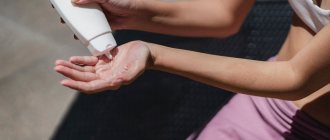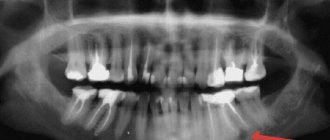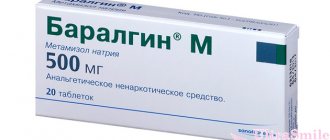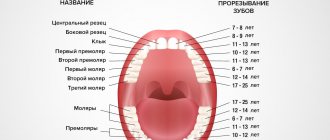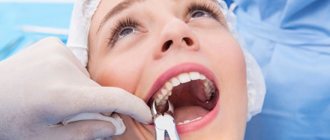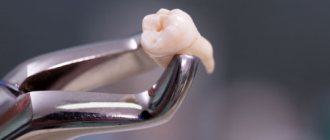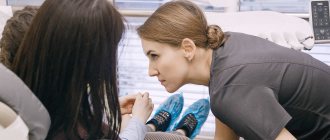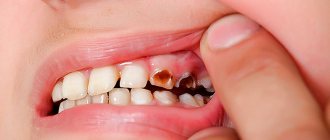Parents always have a number of concerns regarding the health of their children. For example, it is important to know how a mother herself can correctly and quickly pull out a loose baby lower or upper, front or chewing tooth, fang or incisor, at home so that it doesn’t hurt, the better with dental floss or sewing thread, or without them, just with your hands, Is it even possible to do this yourself, how to help you heal faster and survive the recovery period on your own and painlessly, without complications and at home.
When they start to fall out
This phenomenon can be encountered when the child turns 5-6 years old. It occurs due to the fact that the jaws begin to grow. It is completely painless for most children, due to the fact that during the growth of the radical replacement, the roots of baby teeth are reabsorbed. They become mobile and then fall out. This is ideal.
There are cases when improper formation is observed, especially of premolars, and very rarely of incisors and canines. Due to the violation, resorption does not occur on time. Careful removal is required so that they can grow healthy and even in the future.
Lasts up to 10-12 years, depending on the individual characteristics of the body. Interestingly, in girls it begins earlier and proceeds much easier and faster than in boys.
Content:
- Are baby teeth pulled out?
- How to remove a baby tooth yourself
- Removal technique
- If teeth are removed too early
- If you had to remove several neighboring units prematurely
- Caring for the child's psyche
Removing children's teeth is an exciting event for both the child and his parents.
All mothers and fathers want the manipulation to be absolutely painless. And it’s better if everything happens at home. But you should not focus on pulling out incisors, canines and molars at home. If there are indications for the removal of a loose baby tooth, but the child does not want or cannot loosen it on his own, he should make an appointment with pediatric dentistry.
Here, thanks to the use of modern topical anesthetics and pain-relieving sprays , surgery takes place without pain and is almost invisible to the baby. While the doctor removes a baby tooth, the little patient calmly watches his favorite cartoon.
Should I rush to delete it?
Parents are interested not only in how to correctly pull out a child’s tooth, but also when it can be done. A clear answer to the question is not recommended without medical indications. Because the rudiments have not yet fully formed. They will not erupt for a long time. The absence of at least one element of the dentition leads to the fact that the rest begin to slide, taking up free space, which leads to an incorrect bite. Those that should be in a specific place will not come out before their due date. This means that when the time comes, they simply will have nowhere to grow.
Among the dangerous consequences of this procedure:
- the appearance of painful and unpleasant sensations during teething;
- change in diction, habit of burring;
- incorrect jaw structure;
- problems with digesting food.
Therefore, it is better to refrain from deleting in advance if there is no reason for this.
Tooth extraction in children: indications
At the age of five or six years, the process of replacing baby teeth with permanent ones begins.
Unfortunately, many parents mistakenly believe that there is no need to treat baby teeth. This often causes the development of pathologies that ultimately lead to the need to completely remove the tooth. Here are some indications for tooth extraction in children:
- Presence of advanced caries. If caries has destroyed a tooth so much that it is not possible to restore it, the doctor, as a rule, recommends removing the tooth;
- Development of a cyst at the base of the tooth. A baby tooth injures surrounding tissues and causes inflammation;
- Difficulty with baby tooth loss;
- The presence of serious damage - chips, microtraumas;
- Referral from an orthodontist;
- The presence of periodontitis, sinusitis or fistula on the gums;
- Additional, super-complex teeth.
Permanent teeth in children are removed quite rarely, usually due to advanced caries and its complications. In addition, their removal is recommended in the following cases:
- The presence of an unerupted molar for which there is no space;
- Severe forms of periodontal disease;
- Serious injuries to permanent teeth.
Indications
Among the cases when the doctor may insist that the milk needs to be vomited:
- advanced caries, which can cause infection in the oral cavity;
- cyst;
- a loose element of the dentition injures the gums, which leads to inflammation;
- long-term spontaneous loss;
- chip, crack or other injury;
- orthodontist indications;
- phlegmon;
- periodontitis;
- fistula;
- sinusitis.
If there are such reasons, it is necessary to remove the traumatic element ahead of schedule so that it does not lead to serious diseases of the oral cavity.
How to understand that a tooth can be removed
Baby teeth begin to loosen at about 5-7 years of age.
A loose tooth can cause a lot of trouble for a child. The difficulties are mainly related to eating. With a loose tooth, it is difficult to eat solid foods, for example, raw fruits, vegetables, crackers, etc. Sooner or later, the baby tooth will fall out as it is replaced by a permanent tooth. Many people force this process, since a loose baby tooth is a source of discomfort in the oral cavity, which they want to get rid of as soon as possible. But how to pull out a tooth at home, and is it worth doing it yourself? A reasonable solution to this issue is to consult a doctor. But in practice, few people go to dentistry to remove a baby tooth. Therefore, if you decide to remove a child’s tooth yourself, then make sure it can be done.
First, examine the child's oral cavity using artificial light. Make sure there is no swelling in your mouth and your gums are a healthy pink color. Also make sure that the child does not have caries or other dental diseases, chips or cracks. If you find any, consult a doctor and give up the idea of removing them yourself.
The most important condition for removing a baby tooth is its mobility. If it wobbles slightly, then it’s too early to tear it. You can remove it when it is very loose. When you wiggle your fingers, you should be left with the impression that the tooth is being held on by one string. If the range of movements is insufficient, then persuade the child to be patient until the right moment arrives.
Is it possible to pull out baby teeth yourself: when is it allowed?
You can help your child yourself only in a few cases. The main thing is that everything has its time. There are elements of the dentition that fall out naturally at the age of 5-8, or those that children lose closer to adolescence. Parents need to know about the location and timing of each one. If a loose element is about to fall out in time, you can help it, and if not, consult a doctor.
You should not run to the doctor if the second row appears. This sight is unaesthetic and often causes horror and an urgent visit to the dentist. This process occurs due to the fact that children have an excess of beneficial microelements in the body; accordingly, the formation of new ones occurs faster than the resorption of milk roots. Removal is not required; after timely loss, the root one will take its place. If this does not happen, braces may be available to help.
What should you consider when removing a baby tooth?
The following are taken into account:
- Anatomical features. The walls of primary teeth are relatively thin, and the roots can go deep at a large angle. Therefore, their removal requires the use of special forceps, which help eliminate the possibility of damage to the tooth walls. Pulling out is done in one motion so that the baby experiences minimal discomfort.
- Pain relief. In most cases, anesthesia is not required, especially if the tooth is already loose. Local anesthesia may be required to remove the nerve. The required dose of the drug is calculated individually for each patient.
- Contraindications to the procedure are diseases that cause bleeding disorders (leukemia, hemophilia), hematomas in the mouth, chicken pox, whooping cough, scarlet fever, influenza, sore throat, etc. Gingivitis and candidiasis can also be a reason to temporarily postpone the procedure.
Possible complications
An increase in temperature, even a slight one, indicates the development of an infectious-inflammatory process, and therefore requires urgent medical attention.
Other possible hazards include:
- change in bite;
- speech defects;
- decreased chewing function;
- prolonged bleeding from the socket, wound infection;
- pain in the area of removal;
- general weakness, hyperthermia.
Treatment of complications is very important. They can lead to dangerous consequences, including sepsis. If persistent hemorrhage, the presence of pus, severe pain, or fever are detected, it is necessary to urgently consult a specialist.
The wound will heal
During the natural process, when an old tooth falls out, a molar very easily erupts in place of soft, non-healed tissues. In case of mechanical intervention and tightening of the wound, a scar appears, through which it will be very difficult to break through. This will lead to pain and possible abnormal growth of the new tooth.
Damage to the primordia
If the technique is violated during removal, the growing ones can be damaged. Unformed tissue is very sensitive to mechanical stress, which can result in significant problems in the future. If you decide that you are definitely pulling out a child’s tooth at home, you should be prepared for:
- curvature, irregular formation;
- in places of damage to the top layer - the formation of caries;
- darkening of the enamel;
- displacement.
Therefore, it is necessary to resort to such intervention only when indicated.
The bite is disturbed
The most common problem that occurs when pulling out incorrectly is displacement. Associatively, you can imagine it like this:
- Dairy is a definite benchmark for growth.
- The root one rests on the roots and strives upward.
- After mechanical impact, the direction is lost, which leads to the fact that the dentition moves. Correction with braces may be required.
This is only one of the possible development options. If you remove them too early, the remaining ones will try to move into the free space. In this situation, there will simply be no room for the new one to erupt; it may come out sideways or second row, after which a lengthy adjustment will be required.
Overload of the masticatory apparatus
Each incisor, canine, molar or premolar has its own function for tearing and processing food. When one of the structural elements of the jaw is missing, the load is redistributed. Due to the fact that the remaining teeth are not designed for it, they are damaged and deformed. There is a possibility of tooth decay, displacement, gum disease and many other problems in the future.
Dangers of Home Removal
There are enough of them to make a rational choice in favor of professional dentists:
- there is a high risk of infection, because introducing dirt and infection into the hole will lead to suppuration;
- damage to molar primordia can cause damage to adult teeth;
- when tying with thread and other improvised means, the gums are often injured;
- displacement of the dentition, changes in the bite, subsequently problems with digestion and diction.
It is better to trust the experience of professionals than to risk the health of the child.
Is it possible to remove baby teeth yourself?
In most cases, children cope with this problem themselves when the tooth is sufficiently loose. In this case, there is no need to use excessive force to remove it.
It takes up to 6 days from the moment of loosening to falling out. A loose tooth brings discomfort to the child, preventing him from eating solid food. Therefore, when the tooth is already loose enough, children (or parents) remove it on their own. In other cases, “independent activity” in this matter is inappropriate.
When NOT to do this
There are a number of circumstances under which you should not pull out a child’s tooth at home. Let's look at typical cases when this procedure cannot be done at home:
- Psychological unpreparedness . Children are afraid to take such a step. This should not be treated with disdain. What seems like a trifle to adults is a tragedy to a child. These are emotions and strong experiences from which it is better to protect the child. If you notice that the child does not give in to persuasion, then you should not insist on your own. Moreover, such a procedure cannot be carried out by force.
- Acute and chronic pathologies . If the child has any acute or chronic diseases, then the procedure should be postponed or abandoned altogether. In the presence of other diseases, the removal of a baby tooth sometimes results in the development of serious complications. Only a competent doctor will be able to assess the risks and perform the procedure without complications for the child’s health.
- Hemophilia . This is a rare hereditary disease in which blood clotting is impaired. People with hemophilia are at risk of losing too much blood even from minor injuries. For this reason, a banal tearing procedure leads to large blood losses.
- Increased body temperature . The procedure is undesirable at elevated body temperatures. Even if the cause of such a symptom has not been established, the procedure should be postponed until the temperature returns to normal.
- Infectious pathologies of the oral cavity . We are talking about pathologies such as gingivitis, stomatitis and others. The danger of unauthorized removal in case of an infectious lesion of the oral cavity is the risk of introducing infection into the bloodstream.
- Inflammatory pathologies of the oral cavity . You should postpone tooth extraction if there is swelling or redness of the gums, cheeks and mucous membranes.
- Affected teeth . If the tooth that is to be removed is affected by caries, then this should only be done in a dental setting. Also, self-removal should be avoided if there are cracks or chips in the enamel.
- Painful tooth . This problem should be dealt with by a dentist. Self-removal in this case often leads to complications.
You should also refuse to remove it yourself in cases where you are not confident in your own abilities. If you have never pulled out a baby tooth before, then you should not experiment. During the removal process, something can go wrong and this will lead to undesirable consequences. In this case, it is better to entrust even a very loose baby tooth to a professional who will do this without harming the baby’s health.
How to make it fall out yourself
The best and painless option in all respects is the natural process of change. However, it happens that the milk begins to wobble long before it falls out, which brings a lot of discomfort to children and worries parents. There are several ways to speed up spontaneous loss without causing harm.
Tongue loosening
Children are often told not to lick a loose tooth. There is an established myth that new ones may not grow evenly. This statement is completely false. When talking, eating, we constantly touch our teeth. When changing, this is necessary so that the loss occurs faster.
Do not be too zealous and press with your tongue, applying force. Light loosening will be beneficial and will help develop the gums. This should not be allowed if the dairy is not yet very wobbly. When the replacement process just begins, you need to wait the time necessary for root resorption. Otherwise, you can damage soft tissues or the rudiment and cause an infection.
We resort to using our fingers
After watching a video of children having their teeth pulled out at home, many parents decide to repeat what is not the safest and most hygienic option. The hands contain a huge amount of bacteria that will be transferred to the oral cavity. You can miscalculate the force and injure the gums, where an infection will develop.
You can try to loosen it with your fingers without applying pressure. Just moving it a little in different directions. If pain occurs, stop and go to the dentist. It is possible that the infection has already entered the tissue, which is fraught with complications.
Another contraindication is that the roots are still sufficiently attached to the hole. Parents will not be able to check this on their own; it is necessary to consult a doctor who will give recommendations on whether the root canal will appear soon or whether it is necessary to wait a little longer before accelerating the loss.
We clean with special zeal
Toothbrushes are designed taking into account the physiology of the oral cavity. Therefore, it is almost impossible to seriously damage them unless you spend several hours in the bathroom, irritating soft tissues by friction. It is worth increasing the cleaning time by a few minutes and doing it not twice a day, but 3-4.
It is better to go to a clinic, where they will recommend professional soft brushes that do not injure the gums. Hard bristles can scratch and lead to the development of inflammation, gingivitis and periodontitis. Therefore, it is necessary to choose hygiene products for a child during the period of change of bite after consultation with a dentist.
Chewing on solid food
Many self-help tips tell you to eat apples, pears, cucumbers and other tough vegetables and fruits. In part, yes, the chewing process is the most physiological of all, but it can be dangerous.
When a tooth begins to become very loose, the roots in the gums no longer hold well. Accordingly, there is no point of support. When bitten, it easily moves to the side, and sharp clenching of the jaw causes it to break easily. In this situation, parts will remain inside, requiring the help of a dentist, a painful removal procedure, and also the risk of injury to neighboring tissues. Therefore, it is better not to resort to this technique, so as not to make things worse.
Oral hygiene after tooth extraction
Immediately after you have pulled out the tooth, you need to moisten a cotton ball with chlorhexidine and place it in the hole for 10 minutes. If a small amount of blood appears, then use hydrogen peroxide for these purposes - it not only disinfects, but also helps stop minor bleeding.
To form a full-fledged blood clot, as well as to prevent food particles from getting into the wound and causing infection, after the manipulation the child is not allowed to eat or drink for 2 hours. Please note that alcohol and vodka are not used to treat wounds in children.
Further care after baby tooth extraction:
- On the first day, brush your teeth without touching the socket with the brush. You should not use a paste - its components will irritate the wound surface.
- Rinse your mouth with chamomile decoction and a weak soda solution 4-5 times a day for 5-7 days. It is imperative to carry out this procedure after eating to remove food debris - otherwise an inflammatory process may develop.
- Eliminate salty, spicy and hard foods from the diet for 5 days. These products have an aggressive effect on the mucous membrane and can cause bleeding from the socket and pain.
- In children with frequent inflammatory diseases of the oral cavity, a warm antiseptic solution of furatsilin can be used for rinsing.
Author: Zhukov M.A.
Preparing the child
The natural process of changing your bite is usually easy and painless. However, there are times when parental or dental intervention is required. Children are afraid of being hurt, of any outside interference. Therefore, when hesitation is noticed, it is necessary to conduct moral preparation of the child.
It is enough to explain that this is normal. A 5-year-old child will not be able to perceive information correctly, so it is better to use simple figures of speech and a playful form. Mythological children's thinking responds well to all kinds of fairy tales. You can read to your child a special collection of stories dedicated to this phenomenon. Prepare gifts from a fairy-tale character for your patience.
How children's baby teeth are pulled out at home
Before making a decision, it is worth soberly assessing several factors and making preparations:
- Own capabilities. Parents often miss small bumps and inflammation in the gums. They think that swelling is normal. However, any minimal inflammation can lead to cellulitis, malocclusion and secondary infections.
- Compliance. You can't pull those that stand firmly. If they just started to loosen. You can injure soft tissues and cause infection. It is better to turn to specialists than to cause damage that is difficult to repair.
- Tools. You need to prepare special antiseptics in advance and sanitize the oral cavity. Dishes and other things that will help not prolong the unpleasant procedure.
- Psychological preparation. Any movement of the baby, a jerk to the side or severe fright can lead to a violation of the technique, and therefore dangerous consequences. If your child is nervous, capricious, or refuses to sit still, you should trust professionals who know how to remove fidgets.
- Hearty lunch. Afterwards you will not be able to take food or water for 2-3 hours. This time is necessary for the formation of a blood clot in the socket. It serves as a protective barrier against pathogens entering the wound.
When preparing, it’s worth thinking again about whether parents are ready to take the risk and do everything themselves instead of going to the dentist, which will not take more than 15 minutes of time.
How to pull out a child's tooth using floss
The most common method that is often performed incorrectly. Pre-treat the thread with an antiseptic. It’s better to soak it in the solution for a few minutes and let it soak well. It is recommended to use special dental or nylon thread, rather than sewing thread, which can easily break. Then make a self-tightening loop. It is important to secure it well in the root zone; if it slips, it will cause pain.
It is important to perform the technique correctly:
- tear in one quick movement;
- the direction is strictly in the direction of growth, and not sideways or in the opposite direction (you cannot tie a thread to a door handle or other objects);
- If the procedure is violated, fragile tissue without nutrition from the roots may collapse and remain in the hole, which will cause suppuration and infection.
If it doesn’t work out the first time, you don’t need to torture yourself and your child; it’s better to go to a clinic, where the process will be quick and painless.
Using your hands
Be sure to wash with soap and disinfect with an antiseptic, cut off your nails (they are not only a source of infection, but also interfere with grip and retention). Then carry out sanitation of the oral cavity.
Firmly grasp the loose tooth, loosen it, and check its pliability. When you are sure that it will easily succumb to a sharp jerk, pull it out. It sounds simple, but you need to be careful. Tear only in the direction of growth, otherwise there is a high risk of leaving a broken piece in the hole.
If your hands are shaking, there is the slightest fear and uncertainty - you should not take on the task yourself
Home Removal Methods
There are several safe and painless ways to pull a tooth at home.
Using thread
Suitable for older preschool and teenage children. Many people probably know how to pull out a tooth using this method. But at the same time, it is important to remember that the Child must be calm, tuned in to the procedure, and not break out or be capricious. Parents will need to tie a nylon thread around the loose tooth and sharply pull the tip. It is better to hold on to the rope with several fingers at once or wrap it tightly around one.
Make a sharp upward movement if the tooth is lower, and downward if you want to remove the upper tooth. You can’t pull it directly towards yourself; the thread can damage the child’s lip and inner cheek.
Important! Slow, hesitant movements when removing a tooth with floss will cause discomfort to the baby, and the tooth may remain in place. If you can’t pull hard without fear, choose less radical methods.
Hands
To pull out a tooth with your hands, you need to wrap a sterile bandage around your fingers. Grasp the tooth around and twist in different directions. If the tooth wobbles easily, pull down or up (in the opposite direction of growth). Carefully remove the tooth and cover the wound with a cotton swab containing an antiseptic.
This option is suitable for removing baby teeth at an early age and for children who are afraid of any manipulation with forceps or threads.
Important! Before the “surgical” procedure at home, do not forget to wash your hands and disinfect your child’s mouth with mouthwash. Treat the thread with alcohol or brilliant green in advance.
How to care after the procedure
When you pull out a baby tooth yourself, you need to stop the bleeding. To do this, a piece of bandage or gauze is moistened in an antiseptic and pressed against the hole. There is no need to press hard or try to blot all the blood. A blood clot should form. Ask your child to hold the tampon in place with his jaws for a few minutes.
After 3-5 days, the wound will heal completely; there is no need to rinse. This can lead to cleansing of the wound from the protective physiological layer and easy access for bacteria. Take antiseptic baths or simply treat with Miramistin.
